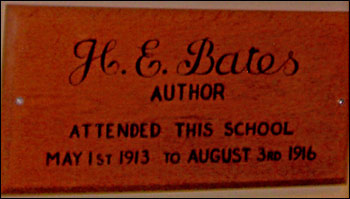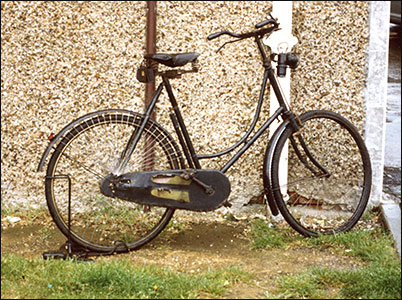|
Dates of the Plaques, where they are, and what they Commemorate
|
|
|
1
|
2006
|
46 High Street South |
Birthplace of Bernard Vann V.C. |
|
2
|
1997
|
Inside 'Asda' Supermarket |
Thurston's Fair 1904 |
|
3
|
2005
|
BMW Windows |
"Stonehurst" (145 High Street) |
|
4
|
|
Heather Court |
Benjamin Ladds' Factory |
|
5
|
1993
|
51 Grove Road |
Birthplace of H. E. Bates |
|
6
|
1993
|
15 Essex Road |
H. E. Bates lived here 1914-22 |
|
7
|
1995
|
Pemberton Centre |
Tree planted - H. E. Bates |
|
8
|
1992
|
12 High Street |
John Radburne - Draper c1850 |
|
|
|
9
|
2001
|
16 Church Street (on No 20) |
Lightstrung Co. (Cycles & Motors) |
|
10
|
1994
|
19 High Street |
The Co-operative Society |
|
11
|
1999
|
20 Church Street |
John White's first factory |
|
12
|
1991
|
67 High Street |
John Cave's Factory - 1901 Fire |
|
13
|
1995
|
17 Moor Road |
Reg Norman - "Air Ada" creator |
|
14
|
1996
|
57 High Street (on 55) |
Palace Cinema |
|
15
|
2004
|
Pemberton Centre |
Tennyson Road School |
|
|
|
|
1
|
Plaque to Bernard Vann V.C.
Situated at 46 High St. South
(Erected Oct. 2006)
|
Bernard Vann was a man who excelled in every aspect of life, from his schooldays until his death in 1918. He was born on the 9th July 1887, educated at Chichele Grammar School Higham Ferrers and later at Jesus College Cambridge. At both he played ‘Soccer’ Cricket and Hockey, becoming captain in all three sports. He also played soccer for Derby County and Northampton Town, and hockey for Leicestershire. As well as his sporting prowess he was also involved in many debating societies. In September 1910 he was ordained at Peterborough and in November of the same year became chaplain at Wellingborough School, where he taught history and theology; also coaching the pupils in football and cricket.
Bernard joined the Sherwood Foresters on the 31st August 1914 quickly rising through the ranks to his eventual commission of Lieutenant Colonel. He married Victoria Beck on 27th December 1916. They had one son born in June 1919. His Victoria Cross was awarded for bravery in the attack at Bellienglise and Lehaucourt on September 29th 1918. Four days later he was killed in another attack. His body is buried in the British cemetery at Bellincourt with the Victoria Cross engraved on the headstone. Other commemorations to him are on the War Memorial in Rushden and in the chapel of Wellingborough School. Finally his memory has been recognised in his place of birth in a fitting manner.
|
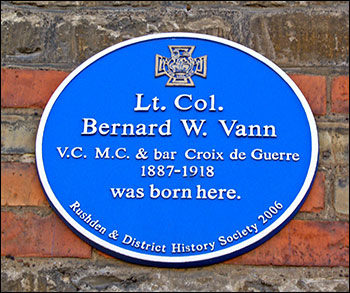 |
|
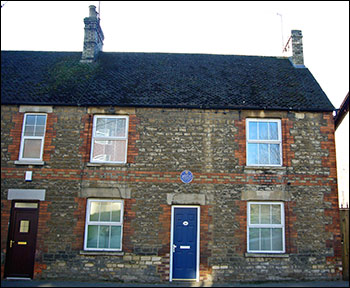 |
|
2
|
Plaque to Thurston’s Fairground
Situated in Asda Supermarket
(Erected Oct. 1997)
|
This plaque has the distinction of being the only one to have been moved, as originally it was erected on the 9th October 1997 on the premises of the old Royal Theatre. When that building was due to be demolished, to make way for Robert Marriott’s offices, Mr Eric Fowell had the foresight to remove it for safe keeping. Since then the offices have been razed to the ground and we have ‘Asda’ supermarket on the site.
The area, originally ‘Franklins-Fields’, was the location of Stanley Thurston’s fairground in 1904. In September of that year amongst the attractions were Swings, Shooting Galleries, Round-Abouts, Aunt-Sallies, Boxing-Booths, etc. However the most popular exhibits were Mr Thurston’s Switchback Ride and the Cinematograph.
It must be remembered that in the early 1900’s entertainment for the working family was very limited, so the arrival of the fair for feast week was very much looked forward to. In fact records show that extra trains and carriages were provided from surrounding areas, swelling the population of Rushden by a considerable amount and bringing with it the problems associated when large numbers of people are gathered in one area; a problem that still exists today.
On reading this, it becomes apparent that the plaque was not on view between the demolition of the Royal and the completion of Asda, a period of approximately 5 years. It was finally, after much pressure from the societies, re-erected in May 2007.
|
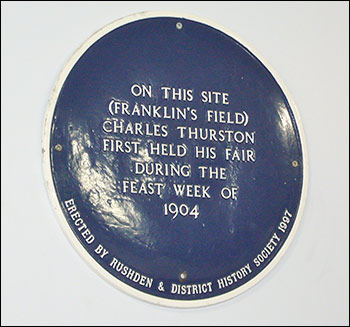 |
|
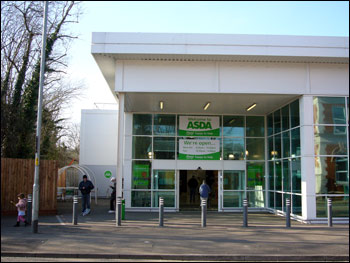 |
|
3
|
Plaque to ‘Stonehurst’
Situated at 145 High Street
(Erected May 2005)
|
Stonehurst was a late Victorian house demolished in 1976, popularly known as the Belgian House because of its connections with the first world war. It was used to house Belgian refugees during this period, the first 19 of whom arrived in October 1914, and were entertained by the Rushden Belgian Relief Committee. In the air raid of 3rd October 1940, this house was hit by the same ‘stick’ of bombs that did so much damage to Alfred Street School. It was originally built as a brewery store and a wine warehouse by Praeds Brewers, long since taken over by larger companies. After the refugees were returned home it was converted into a house, lived in by various families, notably the Wheeler’s, who resided there for 30 years. As mentioned, the house was demolished in 1976 “To make way for new shops”. Those shops have now disappeared in the space of 30 years. It seems that the substantial buildings of the Victorian era were destroyed to make way for so called progress. It makes one wonder how the “Structures” erected today will stand the test of time.
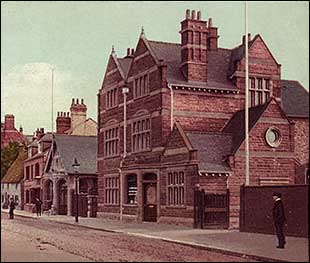 |
Stonehurst in the 1920s. Beyond is the Railway Inn and Bates' Fish Shop which was bombed in 1940.
|
|
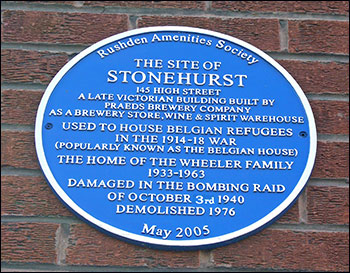 |
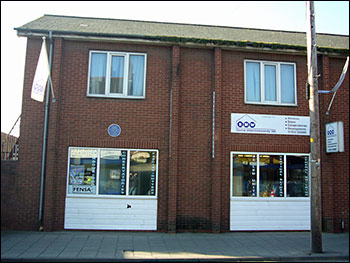 |
|
In 2009 B M W windows have left this property and it is going to be turned into a cafe during the day time and a licensed club in the evenings (2015).
|
|
4
|
Plaque to Ladds Shoe Factory
Situated in Heather Court
(Erected June 2003)
|
Benjamin Ladds shoe factory was on this site from 1891 until 1971, and then demolished to make way for this block of flats.
It is recorded that they made Boots and Shoes for men. No mention of footwear for Ladies, a curious situation for the world of today.
Like so many of the factories in the town it was a family run concern employing about 75 people and according to records Benjamin’s descendants, Benjamin Hugh Ladds and Hugh Selby Ladds, were on amicable terms with their workforce.
They made three brands of high quality footwear; the best was marketed as “B.L. High Grade Brand” and was well known in the trade for first class workmanship.
The next grade down was the “Flying Alligator”, used for all classes of goods for the export trade, and was considered to be a stamp of reliability by most of the shippers; so presumably this quality of boot and shoe was not available for the British consumer.
The last, and probably the one bought by most people, was the ‘Bell’ brand. An advertisement of the time states “this is our reliable medium quality footwear, every pair of which can be recommended and guaranteed.”
The company invited buyers to inspect samples on their premises, or failing that they would send specimens for them to peruse at their leisure.
The factory was at 33/35 Moor Road, and stretched back almost to Wellingborough Road.
|
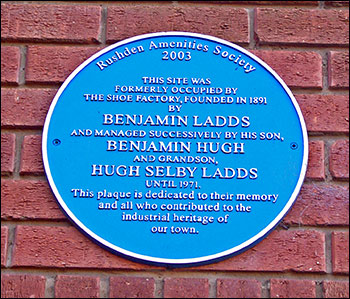 |
|
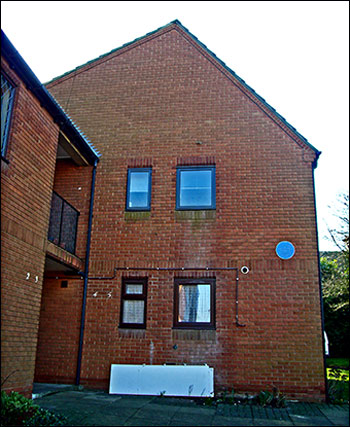 |
|
5
|
Plaques to H.E. Bates
Situated at 51 Grove Road.
|
As befits Rushden’s best known author, the towns’ societies have erected these memorials in memory of him. H.E. (as he is fondly remembered in the town) was born on the 16th May 1905 at 51 Grove Road.
His babyhood and early years were spent here until, at the age of nine, his parents moved into number 15 Essex Road.
His first school at the age of four was Newton Road infants in Rushden, and later the junior section of the same school from May 1913 until August 1916. Then aspiring to Kettering Grammar until at the age of sixteen and a half he left to be a junior reporter for a local newspaper.
He acquired a position in the autumn of 1926 in the employ of a London bookseller. He married Marjorie Cox, a Rushden girl in July 1931, and they left the town to live at Little Chart in the heart of the Kent countryside, where they had two sons and two daughters.
H.E. was awarded the C.B.E. in June 1973, and died in January 1974.
|
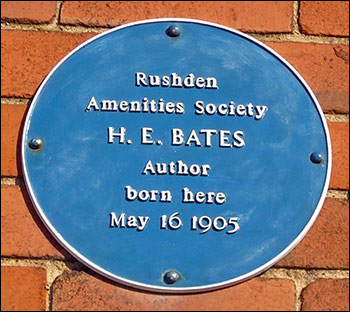 |
|
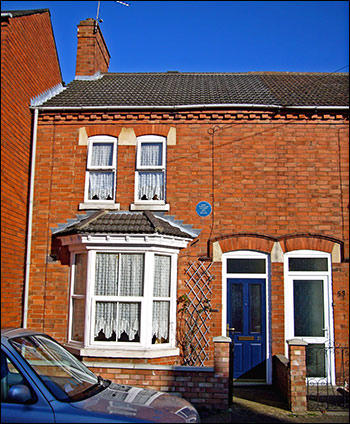 |
|
6
|
Situated at 15 Essex Road.
|
|
Amongst his works of 126 novels, 323 short stories and 194 essays, articles, etc. are:- ‘The Jacaranda Tree’, ‘Oh! To be in England’, ‘Fair Stood the Wind for France’ and, most probably his most well known book, ‘The Darling Buds of May’.
He also wrote under the pseudonym Flying Officer ‘X’ for his military novels.
There are still a number of buildings in Rushden that he used for the locations for some of his novels, most notably Rushden Hall in ‘Hall Park’ used as the setting for ‘Love for Lydia’, where the fictional Aspen family lived.
Also used in the same book is the former ’Sanatorium’, later the hospital, where Lydia was a patient after contracting tuberculosis, and later still a day centre; but now like so many old buildings is vacant and slowly declining through lack of maintenance.
see also Plaque 19 in Part 2
|
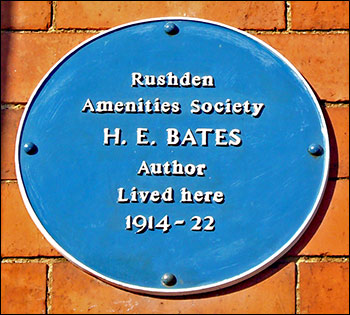 |
|
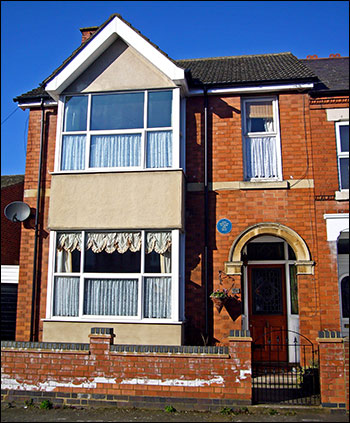 |
|
7
|
Situated at The Pemberton Centre.
|
|
|
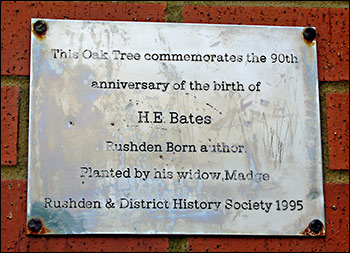 |
|
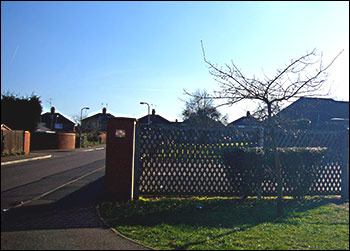 |
|
7a
|
Situated at Newton Road School.
|
In the entrance hall at Newton Road School there is a photograph of H E Bates, with the citation of when he attended this school.
|
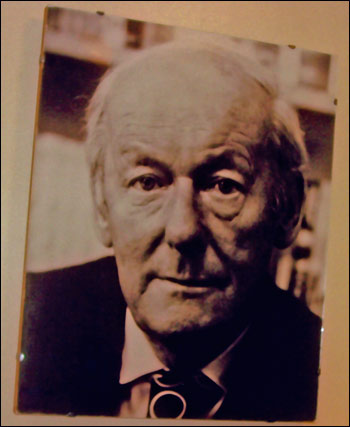 |
|
8
|
Plaque to John Radburn
Situated at No. 12 High Street
(Erected Nov. 1992)
|
This is one of the oldest premises in Rushden. It was used by John Radburne in 1849 for the purpose of buying and selling lace. At that time a great number of the women made lace at home and therefore needed an outlet for their work. John Radburne realised this and also saw the possibilities of selling their products on for a profit, as well as providing the raw materials for them to use. After John died his two sons carried on trading, but it appears that they were not as enthusiastic as their father and the business slowly declined. In later years the property was owned by C. E. Knight, F. Wheeler, E. Warren; strangely all butchers by trade.
Apparently Mr Radburne was a wealthy man because, as well as his shop, he owned land in many of the local areas. He built three cottages at the northern end of the high street known as 'Radburne Cottages' (now the site of a factory outlet store). John was also responsible for the construction, in 1861, of 'Ebenezer Terrace'; another row of cottages that were situated in Newton Road. The date stone can still be viewed today, situated in the wall outside the car park. [John Radburne died in 1879 aged 87]
[stone removed 2015 when Lidl store was built]
|
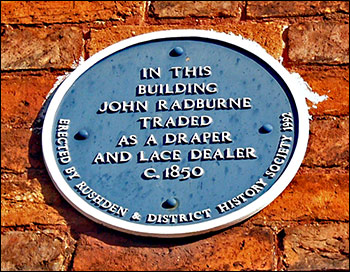 |
|
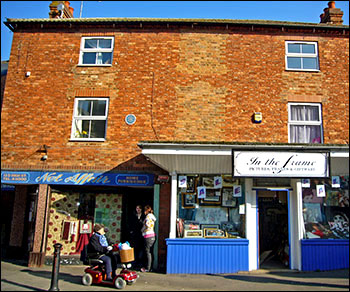 |
|
9
|
Plaque to the Lightstrung
Situated in Church Street
(Erected April 2001)
|
The Lightstrung company was formed in 1886 trading in, and manufacturing pedal cycles, and later on motor-cycles. The directors were Tom, Don, and Harry Denton (presumably brothers). As well as making the products, they had a number of local retail outlets; in Wellingborough, Raunds, Irthlingborough, and further afield in Bedford, Kettering, and Luton. A business directory of 1902 records a Lightstrung Cycle and Engineering Works at 16 Church Street Rushden. They were fortunate as regards advertising because the factory was situated on the bus route. Therefore people came to know the factory by reason of the buses stopping there and the fact their products were advertised in the timetables.
The name originated because the bicycles were both “Light” and “Strung” ( Ruzdin for ‘strong’). When the manufacture of their products ceased, the premises became a motor garage. They were agents for Morris, Wolsley, Standard and Triumph cars; sadly well known marques of yester-year. The company closed down on the 31st July 1970. An example of their craftsmanship can be seen in the Rushden Station Museum. The name lived on as most coach tours, private and national, specified “The Lighstrung” as the pick up point.
Recently by 2018 most companies had renamed the pick-up as Skinners Hill, but the older locals still use the Lighstrung!
|
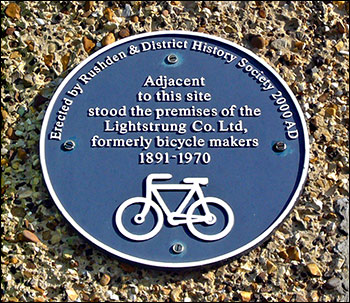 |
|
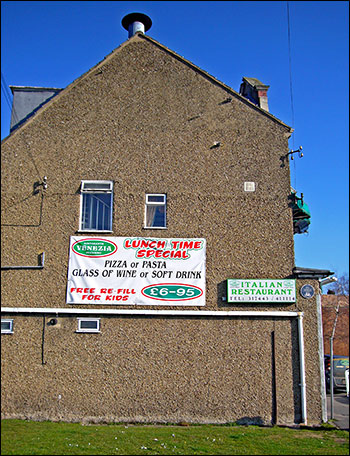 |
|
10
|
Plaque to the Co-op
Situated at No. 19 High St.
(Erected March 1994)
|
This location is the site of the first of many Co-op shops in Rushden. It was built in 1878, although the Co-operative business was started in Rushden long before that. The first record available is that a Co-op shop was kept by a Mr. Denton but unfortunately it failed and was closed down in June 1860. The next person to open a shop was Mr. Darnell in 1876 and for the first two years he conducted the business from his front room, until number 19 High Street was built in 1878. He lived where Wymington Road joins with Bedford Road. His first wage was sixpence in the pound for every pound of sales.
The first shops sold mainly groceries, but as their popularity developed many more outlets were built specialising in meats, clothing, shoes, furniture, etc.; in some areas, even fuels and garage facilities.
Some of you will undoubtedly remember the ‘Divi’, possibly remembering the number. But all that has disappeared.
|
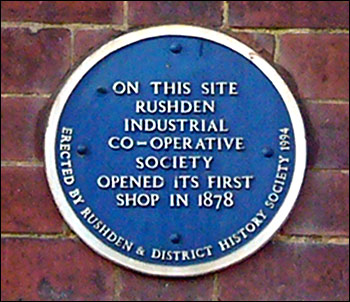 |
|
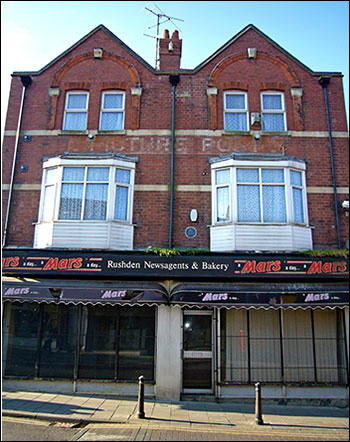 |
|
11
|
Plaque to John White
Situated in Church Street
(Erected Jan. 1999)
|
John White’s second factory was here from 1920 until 1922. It was also the head office. He started making shoes in 1919 in a former paint shop until he was able to purchase these premises, so this was his first ‘proper factory’. He continued to prosper, expanding his workforce and premises to its peak in 1941, when three million pairs of boots and shoes were produced annually. In 1939 his best known factory was built in Lime Street, and by 1941 he owned nine factories employing two thousand workers. The main production during wartime was supplying the military with footwear, both in the Spanish civil war of 1936-1939 and the second world war. By 1941 the factories had produced eight million pairs of footwear for the armed services.
Not that he was a militant man, just using the market available to him at the time; thereby keeping his staff in employment, and his business profitable. In fact when the 2nd World War was over he exported over 400,000 pairs of shoes to America, which at the time was 90% of the total exported from the United Kingdom.
He treated his workers well, arranging social events and outings for them. In 1951 a visit to the Festival of Britain was arranged for all the staff - 2500 of them - and a piece of land was purchased in Bedford Road for use as a sports club. Today it is known as John Whites golf links. He had the bandstand in Hall Park built in 1935, sadly vandalised.
It would have seemed inconceivable to his staff of sixty years ago that today the shoe industry in Rushden is virtually non-existent. But then this could apply to most of this country's manufacturing base.
|
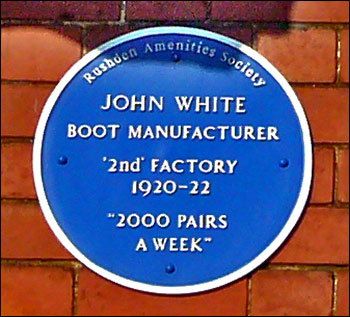 |
|
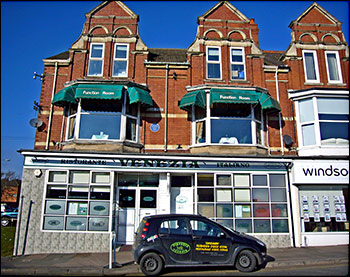 |
|
12
|
Plaque to John Cave
Situated in the High Street
(Erected November 1991)
|
The shoe factory of John Cave was established in 1850 but fate decided that the following years would be calamitous. In April 1877 the fire brigade was called out at midnight to attend a fire at the factory. But by the time they arrived it was too late, and the factory was destroyed. The loss was estimated to be in the region of £3,000 pounds. A second tragedy was to occur a few days later when Mr Elias Cave was killed by a falling wall whilst inspecting the damage.
However temporary premises were found and production continued until a new factory was built on the original site and adjoining land. These proved to be amongst the largest shoe factories in Northamptonshire; 8,000 pairs of shoes per week were made in 1889 and the workforce was 600+.
On the 19th July 1901 disaster struck again. During the dinner hour another fire broke out, and once more the premises were razed to the ground. It was regarded as a tragedy for the town but, with courage undaunted, the Caves built another factory in College Street and production resumed by 1902.
The next misfortune to affect the factory, now in College Street, was in October 1940 when two bombs fell on the premises killing four employees and injuring about forty others. (this was the same stick of bombs that did so much damage to Alfred St. School).
A curious fact is that no other shoe factory in Northamptonshire was bombed during the war!
Eventually the premises were taken over by the Eaton shoe manufactures. They continued production until, like so many other shoe businesses, it closed down and the factory was demolished in 1980. The site is now the premises of “Wilkinson's” general store.
The High Street was redevloped, and the Evening Telegraph Office (closed 2012) was selected for the blue plaque, being central to where the factory destroyed in 1901 stood. |
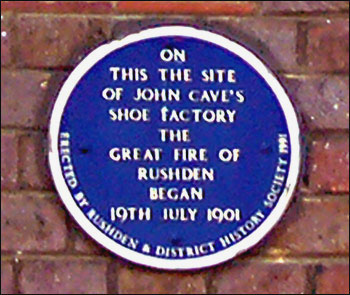 |
|
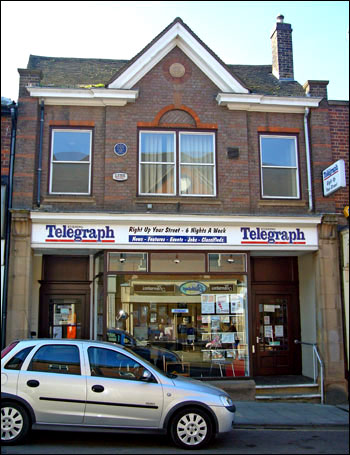 |
|
13
|
Plaque to Reg. Norman
Situated at No. 17 Moor Road
(erected September 1995)
|
Mr. Norman or “Reg.” as he was known to the people of Rushden, probably never thought he would be recognised by the erection of a “Blue Plaque”. He was just a local man who loved listening to and talking in the local dialect. His trade was making leather washers from premises in College Street, unfortunately no trace of which remains. There are still some people alive today who have first hand knowledge of the dialect spoken in the shoe factories of yesteryear, popularly known as “Rushdenese”.
Reg. decided to try his hand at writing poems in this strange to us language, (but which can be understood with some concentration). In this venture he was very successful and examples of his work can be read in the museum and the History Society’s archives. He composed “Air Ada” as a regular feature in the local newspaper on a weekly basis. This of course necessitated him to write at least one article a week. He never had any books published, but some examples of his work have been incorporated in various publications over the years. He never wrote anything malicious or derogatory, but chose to depict life in his inimitable style.
|
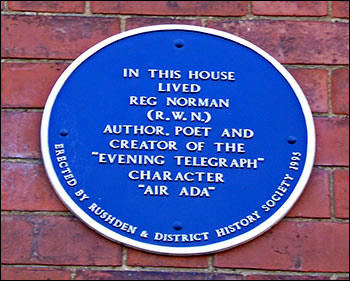 |
|
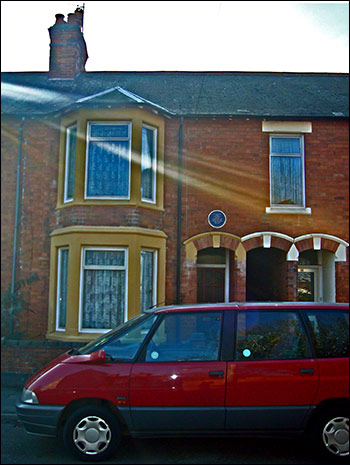 |
|
14
|
Palace Cinema Plaque
Situated at High St.
(Erected September 1996)
|
This plaque is situated at the entrance to the old Palace cinema which was opened on September 19th 1910. The main auditorium extended through to Alfred street. The first programmes consisted of live variety and cinema shows. Admission prices were 2d, 4d and 6d, with seating for 543 people. The cinema generated its own electricity using two oil powered engines. “Talkies” were not installed until 1930, when the admission prices were now 6d, 9d, and 1/- in the stalls, 1/3 and 1/6 in the balcony.
The significance of this plaque is probably not appreciated by the people of Rushden. There were only 100 of them placed in the country, marking the centenary of 100 years of British cinema. The locations were chosen to record sites of significant interest and also recognising persons who were pioneering in the interests of British cinema. Of the original 100 quite a few of them have been lost. But then some of them are in more prominent positions, so it is in our hands as to the fate of ours.
The Palace was viable until it closed down on 6th November 1956. The area is now occupied by a block of flats.
click here to view the press report of the unveiling
|
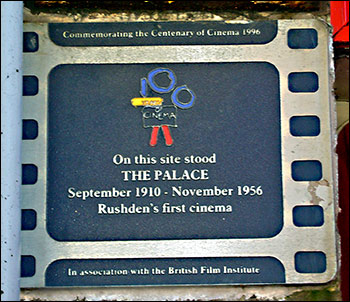 |
|
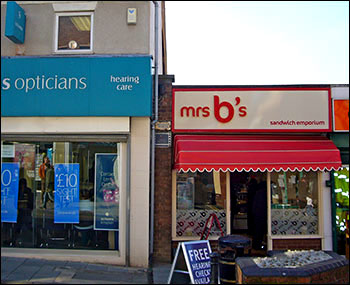 |
|
15
|
Plaque to Tennyson Road County Modern School
Erected at the Pemberton Centre
|
This plaque was erected at the Pemberton Centre on November 12th 2004, when 50 old boys of the School met for their 4th annual re-union. Clive Wood is holding the plaque.
The Pemberton Centre sports hall was erected on the site of the former school playing field.
|
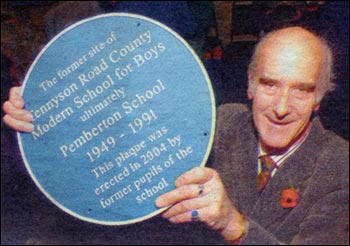 |
|
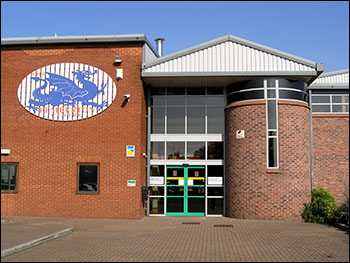 |
|















